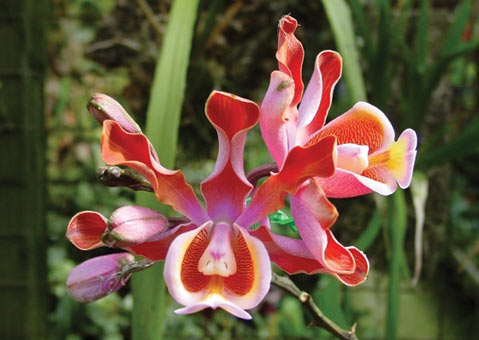Santa Barbara Orchids
Three Dozen Orchids Sport Our City's Name

Not only is Santa Barbara known for its prodigious production of those lovely blooms known collectively as orchids; it has been immortalized in their very nomenclature. There are dozens of cultivated varieties in many genera of orchids that now have Santa Barbara as part of their official name. I recently did a search of Santa Barbara Orchid Estate’s Web site (sborchid.com, a great source of information about orchids, by the way), and there were three dozen in their catalog that sport our city’s name (hmm, wonder if any were actually named for the saint herself?).
There are thousands of cultivated orchids that have sometimes very complex names reflecting their parentage. This is not so surprising, actually. The family comprises something like 19,500 different previously described natural species (and botanists are still finding more). Their seductive scents and evocative floral forms have made them targets of plant collectors for centuries. And, of course, these humans who search the world over to find the next, most beautiful or most desirous collectible don’t stop with wild-grown species. No, no, they fiddle a little here and fuss a bit over there, and soon there are new combinations of genes expressing themselves in before-unseen forms and colors. These new creations need names and are prime for marketing. Finding a name as appealing as the flower itself leads to all sorts of fancy. Because Santa Barbara has also seduced many people, its name is one that can be aptly applied to some of the finest selections.
Starting at the beginning of the alphabetical list is Arpophyllum giganteum ‘Santa Barbara’, a striking species with sturdy flower stalks covered in hundreds of tiny orchid pink flowers. Brassia verrucosa ‘Santa Barbara’ has delicate, spidery flowers in pale yellow and brown speckles and survives temperatures down to freezing. Up next, a selection of an orchid popularized in corsages, Cattleya maxima ‘Santa Barbara’ with richly colored lilac flowers. Then there are a slew of cymbidiums celebrating their origin here. There are large ones such as the green-flowered Cymbidium Big Ideas ‘Santa Barbara’ and the rich rust-colored C. Highfalutin ‘Santa Barbara’ as well as miniatures like the pretty pink C. Changing Times ‘Santa Barbara’ and C. Candy ‘Santa Barbara’. Too many more to list all of them here, but there are enough with staggered bloom times that you could have a Santa Barbara in bloom nearly year ’round.
The hybrid Dendrobium Ruppiosum ‘Santa Barbara’ produces flower stalks that are massed with small spidery off-white flowers. Laelia Adrienne ‘Santa Barbara’ is one of the most vibrantly colored of the popular laelias, but there is a ‘Santa Barbara’ selection of the white L. albida and another of the darker flowering L. dayana. There are nearly as many laelia offerings as there are cymbidiums, but mention must be made of two selections of L. Santa Barbara Sunset: ‘Showtime’ and ‘Streaker’. Another classy species is Myrmecophila tibicinis ‘Santa Barbara’—flowers are a stunning combination of orange and pink and should be grown more widely. Be sure to also check out Oncidium flexuosum ‘Santa Barbara’ and Sarcochilus hartmannii ‘Santa Barbara’ to round out the collection.
Many of these orchids are easy to care for and can thrive in Santa Barbara-area gardens. Because they usually grow in the canopy of various types of moist forests, they are not subjects for planting in the perennial bed. They will adapt readily to pot culture, though, with a loose and organic-rich medium that their roots can easily penetrate. Most of the ones mentioned here have roots that are covered in a very specialized spongy tissue that quickly wicks up any moisture and slowly releases it to the plant, giving them quite a bit of tolerance to dry periods. With minimal additions of nutrients, these exotic plants can grace our terraces and patios. When they are in bloom, they will tolerate a few moments inside the house as well: gracing the dining table, the bathroom counter, or living room wall niche. Just don’t forget their origins, and give them an infusion of light and water on a regular basis. Ask for cultural advice from your favorite area vendor (and I don’t mean Trader Joe’s).
If you want to experience the beauty and magic of orchids without a commitment to their care, the orchid show hosted by the Orchid Society of Santa Barbara will be held, as usual, at the Museum of Natural History (2559 Puesta del Sol Rd.), this year on Saturday, November 27, 10 a.m.-5 p.m. and Sunday, November 28, 10 a.m.-3 p.m. Call 682-4711 or see sbnature.org.



